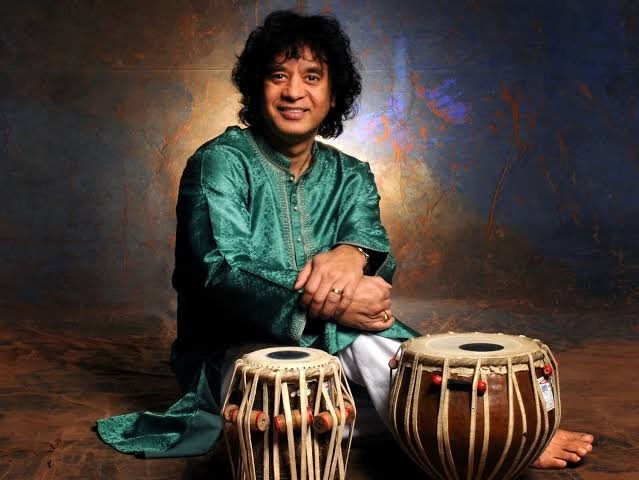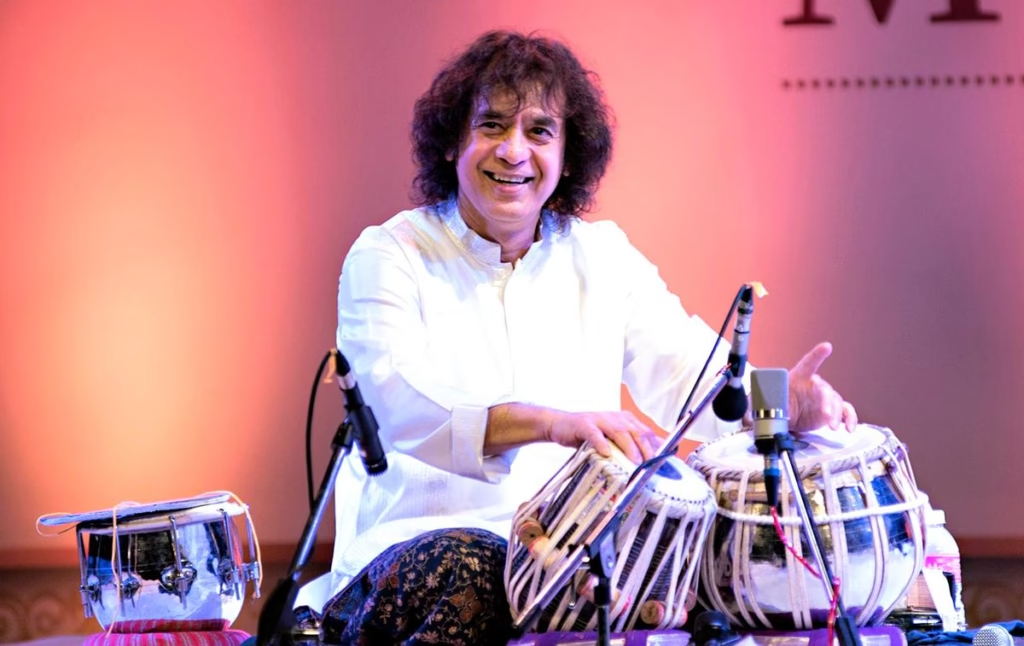On December 15, 2024, the world of music was struck with a profound loss as Ustad Zakir Hussain, the four-time Grammy Award-winning tabla maestro, passed away at the age of 73 in San Francisco. Known for his extraordinary talent and contributions to both Indian classical and world music, Zakir’s departure has left an irreplaceable void in the music community.

Zakir Hussain: Maestro of the Tabla
Zakir Hussain was born into the world of music on March 9, 1951, in Mumbai, India, directly into the lineage of one of the most revered families in the realm of Indian classical music. His father, Ustad Alla Rakha Khan, was not just a tabla maestro but also a pivotal figure who brought the tabla to international audiences alongside luminaries like Ravi Shankar. This familial background set the stage for Zakir’s remarkable journey in music.
From an incredibly young age, Zakir was surrounded by the sounds of the tabla. His father began teaching him this complex percussion instrument when he was only three years old. His prodigious talent was unmistakable; at the tender age of seven, Zakir performed his first public concert, which was just the beginning of a lifetime dedicated to mastering and innovating the art of tabla playing. By his teenage years, he had already established himself as a child prodigy in the world of Indian classical music, performing in concerts across India and garnering the admiration of audiences and peers alike.
Mastering the Tabla
Tabla, with its dual drums, the bayan (left drum) and the dayan (right drum), demands not only technical skill but also an understanding of rhythm and composition that is both precise and expressive. Zakir’s training under his father was rigorous, steeped in the traditional gharana (style) of Punjab, known for its dynamic and expressive playing. However, Zakir did not limit himself to traditional boundaries. He was influenced by various musical styles and cultures, which later played a crucial role in his global impact.
His technique was not just about following the established patterns but about innovating within them. Zakir introduced new compositions, explored different rhythms (talas), and played with a level of expression that made each performance unique. His ability to adapt traditional Indian rhythms to contemporary music contexts was groundbreaking, leading to collaborations that were as diverse as they were influential.
Accolades and International Recognition
Zakir Hussain’s contributions to music were recognized both nationally and internationally. In India, he was honored with the Padma Shri in 1988, acknowledging his excellence in music. This was followed by the Padma Bhushan in 2002, and the highest civilian award in India, the Padma Vibhushan, in 2023, reflecting his status not only as a musician but as a cultural ambassador.
On the global stage, Zakir’s accolades are equally impressive. His Grammy Awards are a testament to his ability to transcend musical genres. In 1992, he won his first Grammy for “Planet Drum,” a collaborative album with Mickey Hart of the Grateful Dead, which was not only a fusion of world music but also became the first album to win in the newly created Best World Music Album category. This victory was symbolic, marking the global acceptance of Indian music in a mainstream context.
However, his most celebrated night at the Grammys came at the 66th Annual Grammy Awards where he won not one, but three awards in a single evening. These awards recognized his work in various categories, showcasing his versatility and influence in global music scenes, from jazz to classical Indian music.
A Global Musician
Zakir Hussain’s influence extends far beyond performance. He has been a teacher, mentor, and innovator. His workshops, masterclasses, and collaborations have spread the knowledge and appreciation of Indian classical music across the globe. His presence in San Francisco from the 1970s helped cultivate a vibrant scene for Indian music in the West, where he became not just a performer but a cultural bridge.
He co-founded the fusion group Shakti with guitarist John McLaughlin, which was instrumental in introducing the world to the fusion of Indian classical music with jazz. This band not only introduced complex Indian rhythms to Western audiences but also influenced countless musicians to explore cross-cultural musical expressions.
Moreover, Hussain’s involvement in film music, like the score for “In Custody,” showed his versatility and ability to convey complex narratives through rhythm and melody. His work in films helped bring Indian classical music to new audiences who might not have encountered it otherwise.
Legacy of Zakir Hussain
Zakir Hussain’s legacy is multifaceted. As a performer, he has redefined the role of the tabla in modern music, both in India and globally. As an educator, he has made the tabla accessible to anyone willing to learn, breaking down cultural and geographical barriers. His collaborations have shown the world the universality of music, where rhythm can serve as a common language.
His influence is not just in the awards or the accolades but in the hearts of those he’s inspired, from budding musicians to international stars. Zakir Hussain’s life and work encapsulate the idea that music is a boundless medium for expression and connection, embodying the spirit of innovation while deeply respecting tradition. His contribution to music will echo through time, inspiring future generations to listen beyond borders and rhythms beyond borders.
Zakir’s teaching methods
Zakir Hussain’s teaching methods are as renowned as his performances, embodying a philosophy that blends traditional Indian musical pedagogy with modern educational techniques. Here’s an in-depth look at how he approached teaching:
Traditional Roots with Modern Twists
1. Gharana System:
- Zakir was deeply rooted in the Punjab gharana of tabla, which he learned from his father, Ustad Alla Rakha. His teaching methods often started with the basics of this style, emphasizing the importance of understanding and mastering the nuances of this specific tradition. However, he encouraged students to appreciate and learn from other gharanas as well, promoting a holistic understanding of tabla playing across different schools of thought.
2. Oral Tradition and Improvisation:
- True to Indian classical music’s roots, Zakir employed the traditional oral method of teaching where students learn by listening, mimicking, and memorizing compositions. This method not only teaches the technical aspects but also inculcates an ear for rhythm, essential for improvisation, which Zakir sees as the heart of tabla playing. He would often engage students in the art of improvisation, encouraging them to explore and express through rhythm.
Structured Learning with Room for Creativity
3. Systematic Progression:
- Zakir’s teaching included a systematic approach to learning tabla. He structured lessons from the basics like holding the instrument correctly, the proper technique for striking each drum, to complex taals (rhythmic cycles). He would break down compositions into smaller, manageable parts, ensuring students understood each element before moving on.
4. Encouragement of Creativity:
- While he taught the traditional compositions meticulously, Zakir was known for encouraging creativity. He would challenge students to create their own compositions or variations on traditional pieces, fostering a sense of innovation while respecting the form.
Interactive and Engaging
5. Workshops and Masterclasses:
- Beyond one-on-one lessons, Zakir conducted numerous workshops and masterclasses worldwide. These sessions were interactive, where he would not only demonstrate but also engage students in discussions about rhythm, its cultural significance, and its application across different musical genres.
6. Use of Technology:
- Recognizing the modern student’s environment, Zakir sometimes incorporated technology into his teaching. He used recordings to illustrate different playing styles, and in later years, might have used digital tools or apps to help students visualize rhythm patterns or practice in sync with metronomes.
7. Cultural Context:
- Zakir believed in teaching tabla as part of a broader cultural education. He would often share stories, the history of Indian classical music, and the philosophical underpinnings of rhythm in Indian culture. This holistic approach aimed at not just making competent tabla players but informed musicians who appreciate the cultural tapestry from which their music comes.
8. Mentorship and Personal Connection:
- His teaching went beyond technical instruction; it was about mentorship. Zakir developed personal relationships with his students, understanding their individual learning styles and aspirations. He was known to guide students in their career paths, not just in mastering the tabla.
Global Influence
9. Inclusivity:
- Zakir’s methods were inclusive, welcoming students from all around the world, not just those from Indian classical music backgrounds. He adapted his teachings to help students from diverse musical backgrounds integrate Indian rhythms into their own styles.
10. Community Building:
- He fostered a community around tabla playing, where students could learn from each other, share their music, and perform together. This community aspect helped sustain interest and provided a support system for learners.
Zakir Hussain’s teaching methods thus combined the depth of tradition with the breadth of modernity, ensuring that the art of tabla playing not only survives but thrives in a global context. His approach was not just about producing skilled musicians but about nurturing artists who could carry forward the legacy of Indian classical music while innovating in their own righ

A Global Influence Of Zakir Hussain
Zakir Hussain was not just a musician; he was a cultural phenomenon whose influence spread far beyond the confines of any single genre or geography. His work in music transcended cultural and geographical boundaries, weaving together the intricate patterns of Indian classical music with the dynamic energies of global musical traditions. This fusion not only reshaped the landscape of world music but also created a legacy that would influence countless musicians and listeners around the globe.
One of the most pivotal aspects of Hussain’s global influence was his collaborations. His partnership with the sitar virtuoso Ravi Shankar helped introduce Indian classical music to a broader audience, particularly in the West. Together, they performed at landmark events like the Monterey Pop Festival, which was one of the first times many Westerners were exposed to the beauty and complexity of Indian music.
However, perhaps one of his most groundbreaking collaborations was with guitarist John McLaughlin in the fusion band Shakti. Formed in the 1970s, Shakti was instrumental in blending Indian classical music with jazz, creating a new genre that resonated with audiences worldwide. Their music was not just a fusion but a conversation between cultures, showcasing how diverse musical traditions could harmonize and innovate together.
Hussain’s versatility extended into film scoring, where he brought his rhythmic genius to the screen. His work on the soundtrack for “In Custody,” directed by Ismail Merchant, is a testament to his ability to adapt and enhance storytelling through music. Here, he managed to juxtapose the traditional with the cinematic, offering both depth and a new dimension to the narrative.
But Zakir Hussain’s influence was not confined to his performances or recordings. As a teacher and mentor, he played a crucial role in disseminating Indian musical knowledge. His workshops and masterclasses around the world, particularly during his long tenure in San Francisco, turned him into a cultural ambassador. He was not just teaching the tabla but was sharing an entire cultural ethos, making Indian music accessible and appreciated by those who might have otherwise remained unacquainted with its nuances. His presence in San Francisco from the 1970s onwards helped cultivate a vibrant scene of Indian classical music in the West, influencing both musicians and enthusiasts alike.
Through his educational programs, Hussain didn’t just impart technical skills but also the philosophy behind the music, fostering a deep respect and understanding for Indian musical traditions. His efforts helped lay the groundwork for a global appreciation of Indian arts, making him one of the key figures in the internationalization of Indian music.
Zakir Hussain’s global influence is a testament to his belief that music knows no borders. His collaborations, his teachings, and his very approach to music have left an indelible mark on the world’s musical tapestry, proving that at its core, music is a universal language that can bridge any divide. His legacy will continue to inspire and guide musicians and music lovers, ensuring that the rhythm of his tabla will echo in the hearts of generations to come.
The Final Notes
Zakir Hussain was admitted to a hospital in San Francisco due to heart-related issues, and despite the hopes and prayers of fans and the music fraternity, he passed away in the ICU. His death was confirmed by multiple sources, including his close friend and fellow musician, flautist Rakesh Chaurasia, who shared the tragic news with the media.
Mourning and Celebration
As we mourn the loss of Zakir Hussain, we also celebrate a life that was a melodious journey through the realms of music. His legacy is not just in the awards or the accolades but in the hearts of every musician he inspired and every listener he touched with the profound rhythms of his tabla. The music world has lost a giant, but his beats will echo through time, influencing generations to come.
We remember Zakir Hussain not only as a musician but as a cultural icon who bridged worlds, a teacher who passed on the ancient art of tabla, and a person whose smile, warmth, and love for music were as infectious as his beats. May his soul find the peace and rhythm in the next world, as he did in this one.
Rest in Peace, Ustad Zakir Hussain
Your rhythms will forever resonate in the lives you’ve touched and the music that continues to play in your honor.
- How ‘Greetings From Your Hometown’ Reflects the Jonas Brothers’ Wyckoff, New Jersey Roots - July 29, 2025
- Upcoming Events of British Singer Charli XCX: Feel Her in a Wedding Celebration Mood - July 25, 2025
- Carly Rae Jepsen’s E•MO•TION 10th Anniversary Concert Set for August 19 at Troubadour in West Hollywood - July 18, 2025

